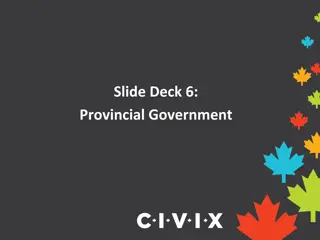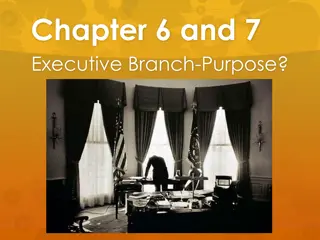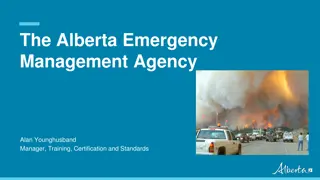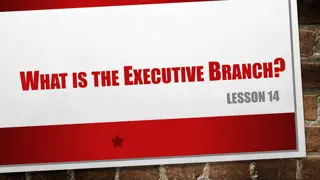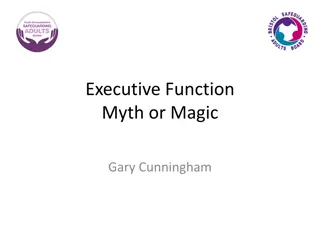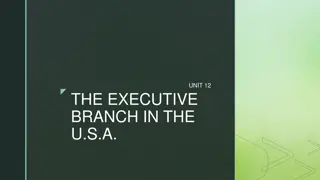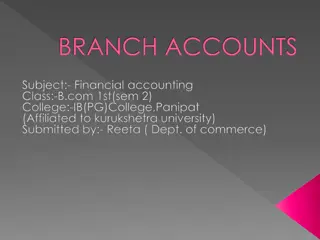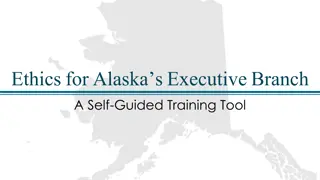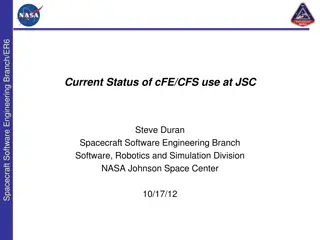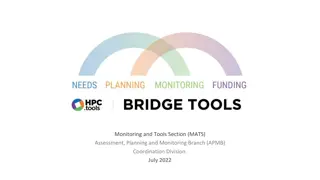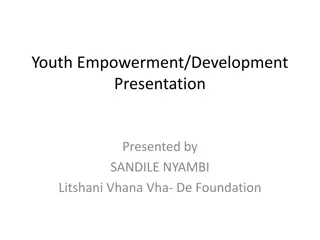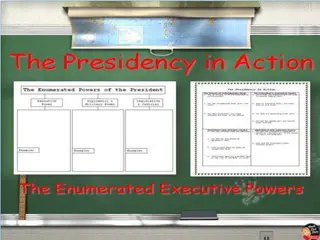NAACP Executive Training and Branch Empowerment Overview
Explore the structure and mission of the NAACP, emphasizing the importance of leadership, unity, and advocacy in ensuring equality and eliminating discrimination. Discover details about the Association's vision, jurisdictional structure, and strategic initiatives for effective branch development. Learn about the Executive Committee's vital role in driving civil rights initiatives within the organization.
Download Presentation

Please find below an Image/Link to download the presentation.
The content on the website is provided AS IS for your information and personal use only. It may not be sold, licensed, or shared on other websites without obtaining consent from the author. Download presentation by click this link. If you encounter any issues during the download, it is possible that the publisher has removed the file from their server.
E N D
Presentation Transcript
NAACP Executive Leadership Training *Building Effective Branches*
NAACP charge The NAACP must be so strong in numbers and so effective in method that no one no Mayor of any city, no Governor of any State, no Congressman of any party, no President of the United States and no Foreign Ambassador will dare to commit any indignity against people of color without realizing the NAACP will challenge them on the platform, in the press, in the courts, in the streets and at the ballot box. Author Unknown
Mission and Vision Mission Statement: The mission of the National Association for the Advancement of Colored People is to ensure the political, educational, social, and economic equality of rights of all persons and to eliminate race-based discrimination. Vision Statement: The vision of the National Association for the Advancement of Colored People is to ensure a society in which all individuals have equal rights without discrimination based on race.
Association Structure National Board of Directors National Office State Conferences Branches & Units
Association Structure JURISDICTIONAL ------------------------- HIERARCHIAL
NATIONAL OFFICE STRUCTURE
Branch Leadership It is a terrible thing to look over your shoulder when you are trying to lead -- and find no one there. Franklin D. Roosevelt A boss creates fear, a leader confidence. A boss fixes blame, a leader corrects mistakes. A boss knows all, a leader asks questions. A boss makes work drudgery, a leader makes it interesting. A boss is interested in himself or herself, a leader is interested in the group. Russell H. Ewing
Executive Committee The Executive Committee shall have general control of the affairs and program of the unit, subject to the authority of the unit and the provisions of the Constitution and approved By-Laws Article VIII, Section 2 Bylaws for Units The Executive Committee is the central nervous system of a unit. Every civil rights concern or action should be filtered to and through the committee.
Executive Committee The Executive Committee of each Branch shall consist of the President, Vice Presidents (not to exceed three Vice Presidents) Secretary, Assistant Secretary, Treasurer, Assistant Treasurer, and the Chairman of the Standing Committees of the Branch, President of the Youth Units in the same community, the Branch Advisors in the High School Chapters, Youth and Junior Youth Councils and such other members at large not to exceed twenty four to be elected at the regular election of the Branch. . . Article VIII, Section 1 Bylaws for Units
Duties of Officers PRESIDENT - Between meetings of the Executive Committee and NAACP Unit, to exercise general executive authority on behalf of the NAACP Unit, subject to ratification by the Executive Committee Article VII, Section 1 Bylaws for Units The President of a Branch is NOT the CEO. Authority in branch is vested in the Executive Committee - The President is also subject to that authority.
Duties of Officers VICE PRESIDENT - To perform all duties of the President in his/her absence or disability. In the event of the resignation, removal, or death of the President, the Vice President(s) shall automatically ascend to the position of President, according to their numerical rank Article VII, Section 2 Bylaws for Units
Duties of Officers SECRETARY - to give members notice of regular meetings and three (3) calendar days notice of special meetings to keep full and accurate records of the proceedings of the NAACP Unit To keep a record of all NAACP Unit members and their dues To give receipts for all membership fees received To submit reports to the NAACP Unit and Executive Committee at all regular meetings Article VII, Section 3 Bylaws for Units
Duties of Officers TREASURER - To receive all monies of the NAACP Unit and promptly deposit the same in the name of the NAACP Unit in a separate account or accounts... To act as the chief financial officer of the Unit and Chair of the Finance Committee To make authorized disbursements upon requisition signed by the Secretary and countersigned by the President To submit reports to the NAACP Unit and Executive Committee at ALL regular meetings or whenever required by either body Article VII, Section 4 Bylaws for Units
Duties of Officers ASSISTANT SECRETARY/TREASURER - The duties of the Assistant Secretary and Assistant Treasurer are to perform the duties of their respective offices in the absence, unavailability, or disability of the Unit Secretary or Treasurer. The Assistant Secretary may also perform specific duties of the Secretary under the supervision of the Secretary and the Assistant Treasurer may perform specific duties of the Treasurer under the supervision of the Treasurer.
Standing Committees The work of the NAACP is done by Standing Committees, not in the General Membership meeting. Standing Committees of Branches. The Standing Committees of the Branch shall be: ACT-SO, Armed Services & Veteran Affairs; Communications, Press & Publicity; Community Coordination; Criminal Justice; Economic Development; Education; Finance; Freedom Fund; Health; Housing; Labor & Industry; Legal Redress; Membership; Political Action; Prison Branch; Religious Affairs; Young Adult; Youth Works; and WIN. Membership and Life Article VIII, Section 4 (c)
Compliance Branches must maintain a minimum of 50 members, File Year-End Financial reports by March 1st, and pay the required assessments - Article 3, Section 3b Units must pay their State Conference assessment and provide a copy of their year-end financial report - 3b Article 3, Section Units must file Quarterly written reports of unit activity - Article 10, Section 1 Youth Council & local College Chapters should be involved in all meetings
Building Effective Branches Be Proactive Be Proactive When you fail to plan, you plan to fail: When you fail to plan, you plan to fail: NAACP units should be proactive in priorities. Each NAACP unit should look toward establishing an agenda of goals and priorities aligned with our Game Changers, then focus its energies on accomplishing the prescribed goals. Unless a unit has a clear, the unit will constantly find itself in a reactionary mode, besieged with hundreds of varied complaints and issues at any given time, trying to accommodate requests for NAACP intervention. Units should seek to avoid the "tail wagging the dog" syndrome. *Clear goals and priorities will also produce better prepared volunteers and help avoid Organizational Drift .
Building Effective Branches Leaders are not born, they are trained: Leaders are not born, they are trained: All officers and Executive Committee members elected at-large should be trained! It is important to ensure that Officers and Committee Chairs attend trainings when scheduled. A budget is like a road map A budget is like a road map - - it tells us where we going: going: The Finance Committee must prepare a budget at the end of each year for the following year. it tells us where we re re Report Memberships in 15 days, not 4 weeks: Report Memberships in 15 days, not 4 weeks: The Treasurer must send all all memberships to the national office within 15 days of receipt.
Bulding Effective Branches File Copies of your Monthly Reports: File Copies of your Monthly Reports: The Secretary should forward copies of your units monthly reports to the State Conference and Regional Office. Written Qurterly reports should be submitted at the Quarterly State Conference meetings. Remember: If it s not in writing, it didn t happen Create and Submit a Year End Activity Report: Create and Submit a Year End Activity Report: The Secretary should send a copy of the Year End Activity Report for the preceding year to the State Conference and Regional Offices following the January Meeting. File Year End Financial Reports by March 1st: File Year End Financial Reports by March 1st: The unit MUST MUST file a copy of the Year end Financial Report by March 1st. A copy should ALSO be sent to the State Conference and Regional Office.
Building Effective Branches Submit to regular audits of your financial processes: Submit to regular audits of your financial processes: Whether internally or by outside agency, you should regularly audit your financial records and processes to ensure that you are in compliance with National Policy. Racism and Discrimination do not take time off: Racism and Discrimination do not take time off: The Branch and Executive Committee must meet at least once a month. The Executive Committee and General Membership should meet on separate days. If there is a meeting, there must be an agenda: If there is a meeting, there must be an agenda: There should be no meeting without a published agenda and clearly understood purpose. Never meet, just to meet!
Building Effective Branches The work is done through ACTIVE standing committees: The work is done through ACTIVE standing committees: The real work of the unit is done through the Active Standing Committees. Committees should consist of no less than 3 people and should meet on a monthly basis. After each meeting, a committee report should be made to be presented at the next Executive Committee meeting. Committee work should not be done during the general meeting. Where there is a Branch there should also be a Youth Where there is a Branch there should also be a Youth Council: Council: Every Branch should ensure there is a active Youth Council in its vicinity. No Branch should have more than 25 youth members. All youth members should be transferred to the Youth Council.
Building Effective Branches Can Can t do the work without the Money, Honey: t do the work without the Money, Honey: The Freedom Fund Committee must direct an effective fund raising program. The program must include the basic fund raising principles: early planning; ask for what you want; clear concise communications; user friendly response forms; don t waste time; and ask for real money from real people. Remember: We don t have fund-raisers to break even. If you only break even, you ve lost. Trainings and Conventions are important Trainings and Conventions are important your unit should attend them all: should attend them all: Every Branch should send delegates to the Regional Convention in the Spring, the National Convention in the Summer and the State Convention in the fall. your unit
Building Effective Branches Transparency is your friend: Transparency is your friend: Rely on our established financial policies. Prepare vouchers for all expenses exceeding $100.00. Two signatures on every check (One from the President, or Vice, and the other from the Treasurer, or Assistant. All expenditures exceeding $100.00 are approved by the Executive committee. Ensure that bank statements are routinely reconciled and that detailed financial reports are made avaiable to the Executive Committee.
Building Effective Branches Let your members know what Let your members know what s going on: communications with members and the public is essential. The Branch should have a newsletter and in many cases radio and cable television programs. Also the Branch should have a Social Media presence. Branch Facebook and Twitter accounts are a good and cost-effective way to reach a sizeable audience. s going on: Regular Track your communications Track your communications Count your contacts: Develop some metric for tracking who you re actually able to contact, who s receiving your newsletter, or who s reading your communications. Work towards increasing that number so that when we need to act in a hurry, you know who you can call on Count your contacts:
Building Effective Branches Know your Story: : Develop your Elevator Speech describing the important points of your work in the unit. When people ask the question, What are y all doing? , you should be able to summarize your work in a brief statement that's consistent and across all members of your branch People won t join if you don t ask: : The number one reason people give for not being a member, is because no one has ever asked them. Keep a few membership forms nearby and ask, ask, ask. It doesn't matter the person's race, age, or occupation, there's a role for everyone in the Association and you'll be surprised by how many people would be willing to join if they are approached.
Building Effective Branches What gets measured gets managed: What gets measured gets managed: Track your Outcomes, not just your outreach. Measure your progress towards achieving your goals and priorities and use that data to help manage your campaigns, communications, and outreach. D x V x F > R: D x V x F > R: This is known as the Beckhard-Harris change model. Dissatisfaction multiplied by Vision multiplied by First Steps is greater than Resistance. If ANY of these elements is missing or insufficient, then change will not occur. People must understand why change is necessary, have a clear picture of the planned outcome, and a clear understanding of the necessary steps to get there, or you won t be able to wage the necessary battle.
Building Effective Branches Relationships are Everything Relationships are Everything - - Meet the Messenger: Having real Relationships with Policy Makers, Elected Officials, and Media personnel is invaluable. Take the time to sensitize them to your issues and help them understand WHY your work is important BEFORE you have a crisis. Meet the Messenger: Be a fly on the wall: Be a fly on the wall: Ensure that your Branch has representation on all of the Boards and Committees that your City and County appoint members to. And for your public meetings, (School Board, City Council, etc ) develop a rotation to ensure that you always have someone in attendance. Follow the Money! and have them report back to the General membership.
Building Effective Branches Beginning at the Beginning: Beginning at the Beginning: Campaigns are not One-Size Fits All . Determine what it is you are trying to accomplish before you launch, and select and/or design a campaign specifically for the task at hand. Don t assume that what worked before will necessarily work again, no matter how similar the circumstances To March or Not to March/The Right Tactics for the To March or Not to March/The Right Tactics for the Right Effect: Right Effect: Choose your campaigns and Direct Actions wisely Marches, Town-Hall Meetings, Hearings, Press Conferences, acts of Civil Disobedience, etc are not inter- changeable. Using the wrong tactic at the wrong time can make the branch appear self-serving, disconnected, or afraid
Building Effective Branches Invite yourself to the Invite yourself to the Meeting before the Meeting Meeting before the Meeting : : By the time a Municipal Government or Board holds a vote at a public meeting, they have already been approached, briefed, and have been given time to form their opinions. The public vote is the LAST step in the process. The time to influence the process comes in the meetings before the meetings Find the Fight/ Find the Fight/ What kind of Peace do you have? What kind of Peace do you have? : : There are two types of Peace The Peace that indicates the presence of justice, or the Peace that indicates the absence of conflict. Sometimes we have to disturb the one to create the other.
Building Effective Branches Volun Volun- -telling import capacity: import capacity: If there are issues facing your communities that need attention, but you lack the capacity to address them effectively, recruit the experts and talent you need to do the job. telling your Volunteers your Volunteers Use recruiting to Use recruiting to People can People can t do what they don t do what they don t know: accountable for Educating the community about issues of importance. Having representation on Boards, committees, and in meetings, will allow you to gather great amounts of critical information that many in the community won t have. Be intentional about creating spaces to share that knowledge with the community at large. t know: Be responsible and
Building Effective Branches Know the Politics of Local Press: Know the Politics of Local Press: Learn the beats of individual reporters and develop personal relationships, meet with your local editorial board, build local e-media tools, and remember most media is Event based, not Issue based. We We ve got 108 years ve got 108 years We don matter how pressing the issue, always take the time to research it fully, develop a real strategy, with measurable goals and real metrics. Credibility is our only weapon, we must guard it, and use it effectively. NEVER cede the Moral high-ground. Don t sacrifice substance for speed. We don t need 15 minutes: t need 15 minutes: No
Building Effective Branches Silos are for Grain: Silos are for Grain: As a uniquely democratic community organization, we are strongest when we are most inclusive. Be intentional about providing opportunities for new and different voices to contribute and fully participate in the work. Speak up! Speak Out! Take Action!: Speak up! Speak Out! Take Action!: The NAACP is a protest organization and the community depends on us to speak out against injustice. When racism and discrimination strikes, a model Branch will speak out and take action. The NAACP Branch must not concern itself with the popularity of the cause. Remember: Our job is not to do what is popular and try to make it right; but rather the NAACP must do what is right and try to make it popular!
Building Effective Branches If you are silent about your pain, they ll kill you and say you enjoyed it ~Zora Neale Hurston
Contact Info Jonathan McKinney: Mid-Atlantic Regional Director jmckinney@naacpnet.org 443-257-4386


